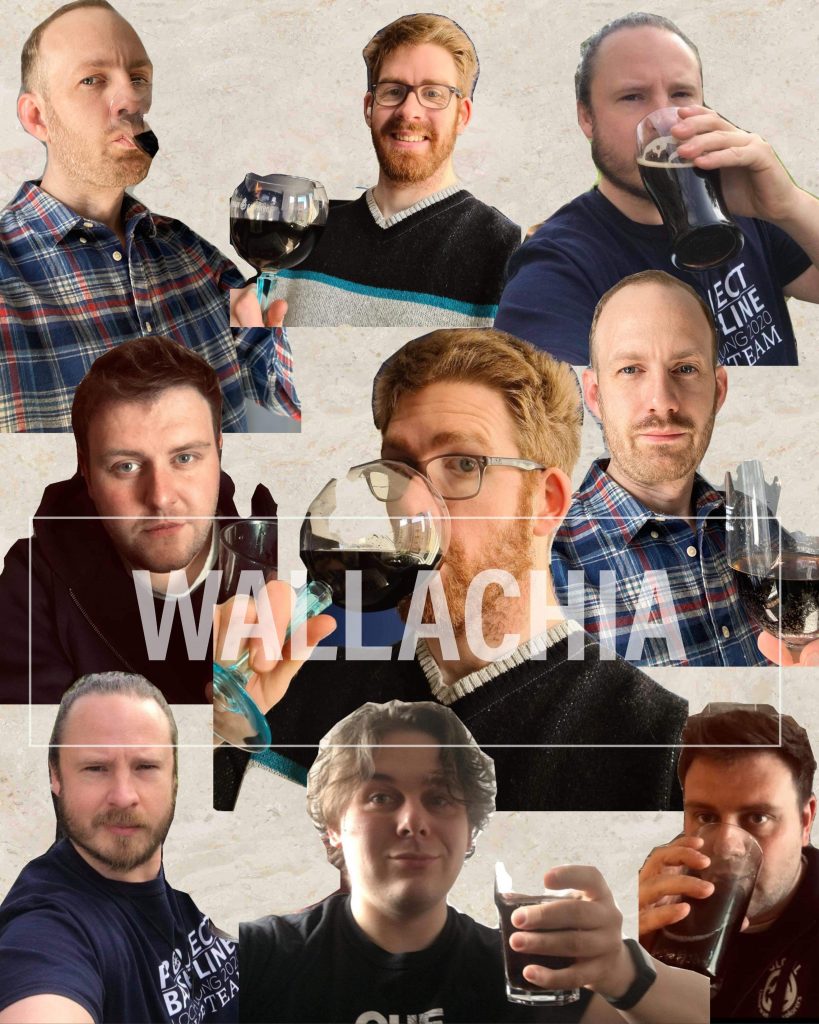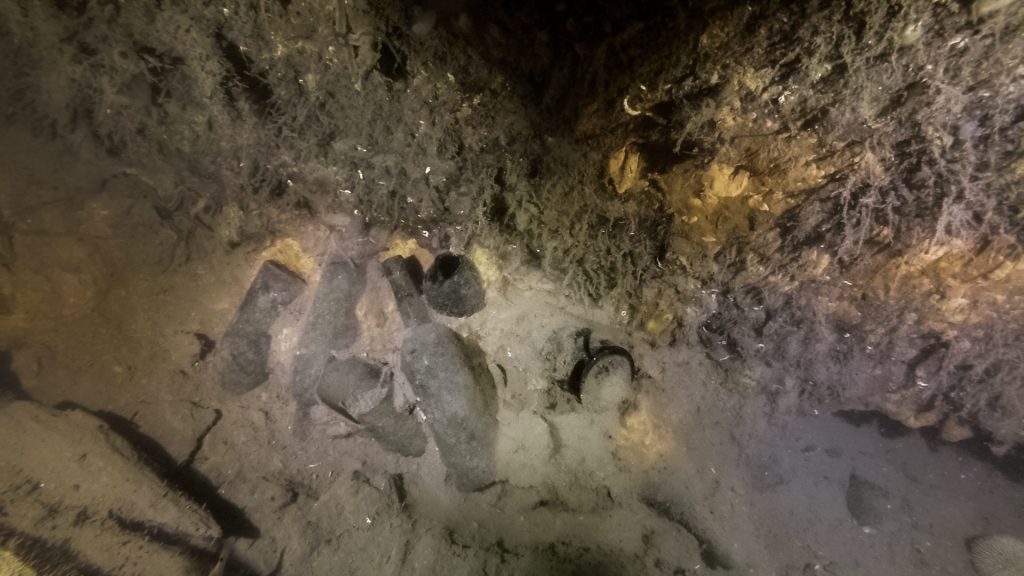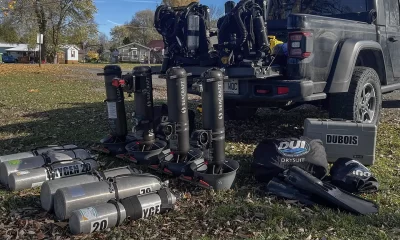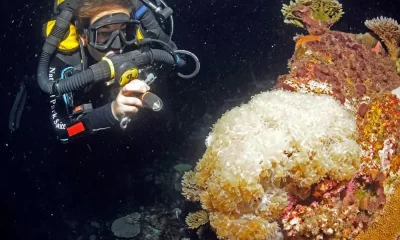Community
Brits Brew Beer Booty
What do you get when you combine British divers’ proclivity for shipwreck exploration with their strong affinity for beer? A tasty treasure hunt on the “Wallachia” that resulted in swilling 126-year old reconstituted British beer. GUE Scotland’s detective chief inspector Andy Pilley recounts the tale.

by Andy Pilley
Images courtesy of A. Pilley
Header Image: GUE Scotland’s brewmeisters enjoying their brew (L to R) Top: Owen Flowers, Andy Pilley, Wayne Heelbeck. Middle: Steve Symington, A. Pilley, O. Flowers, Bottom: W. Heelbeck, Sergej Maciuk, S. Symington
“Give my people plenty of beer, good beer, and cheap beer, and you will have no revolution among them.”
Queen Victoria
I never thought when I started diving 10 years ago, that one day I would be able to sit down for a pint of beer with the team from GUE Scotland recreated from a brew that has been hidden under the waves for 126 years. Let me explain.

The Wallachia was a single screw cargo steamer that was owned by William Burrell & Son of Glasgow, and employed on regular trips between Glasgow and the West Indies. On 29th September, 1895 she left Queen’s Dock, Glasgow at 10am bound for Trinidad and Demerara. On board was a valuable general cargo including whisky, gin, beer, acids, glassware, and earthenware plus building materials and footwear. By 1pm that afternoon she had settled on the seabed of the Clyde Estuary after colliding with another ship in a fog bank, she was forgotten until 1977 when a local sub-aqua club rediscovered the wreck site.
The wreck of the Wallachia lies on an even keel in approximately 34 metres of water on a sandy seabed. The wreck itself is largely intact and has six holds in total, three forward and three aft. In the rearmost hold there are thousands of bottles of beer, some still inscribed with the name of the maker, McEwans of Glasgow. This is where myself and the team from GUE Scotland enter the story.
The Wreck of the Wallachia
The Wallachia is one of the more accessible sites on the west coast of Scotland, where we carry out most of our diving. Depending on weather and tidal conditions, visibility on the wreck can be +10m/33 ft on a very good day or less than 2m/6 ft if there has been a lot of rain due to the amount of particulate in the water. Other elements to consider are the tide as this can vary in its intensity, as well as surrounding boat traffic. The wreck lies in close proximity to a ferry route and care must be taken not to dive when the ferry is closeby. However despite the challenges, the wreck is very rewarding and offers a diver plenty of places to explore and items to look at.
The main point of interest for most has been the rearmost hold, where the bottles of whisky and beer were stored. The majority of the whisky was removed in the 1980’s however a few bottles can be found on occasion, depending where you look. What remains are thousands of bottles of beer, still with the corks and contents intact. Over the course of 2018 & 2019, the team at GUE Scotland dived on the wreck and recovered a number of bottles from the hold.
After a chance discussion with a friend at dinner one night, I was given contact details for a company called Brewlab, which is based in Sunderland in the north east of England. Brewlab specialise in the provision of specialist brewing training, as well as laboratory services such as quality assurance, product development, chemical/microbiology testing as well as long term research options. I made contact with Keith Thomas, the Director of Brewlab, to discuss whether he would be interested in analysing the beer and investigating whether it could be recreated. Needless to say the proposal piqued his interest and arrangements were made for the bottles to be shipped to his lab.
Unbeknownst to me, the recovery of historical beers is rare, due to various sources of degradation/contamination which can affect any residual microbial cells and chemical components left in the beer that were used as part of the brewing process. So these samples are a valuable source of information on past brewing and microbiology. Over the course of 2019/2020, Keith and I kept in regular contact over the progress of the investigations and the full analysis of the beer has recently been published.
A Brewing Interest
Between 1850 and 1950, the application of scientific principles to brewing was becoming increasingly prevalent and microbiology was playing an increasingly important role. A pertinent issue in brewing microbiology around 1900 was the application of pure Saccharomyces yeast cultures developed by Hansen at the Carlsberg laboratory in 1888. These were readily adopted by continental breweries as providing more controlled production and purer beers. Application to UK brewing was, however, less positively received, in part because of the belief that British beers possessed particular flavours arising from mixed yeast cultures and, specifically, the involvement of Brettanomyces species. This was especially believed to be essential for the character of ‘stock’ ales which were matured for extended periods.
While a number of breweries did try pure culture yeasts, UK brewing was resistant to change and, with the intervention of World War I, retained its indigenous yeast cultures. Since the 1940’s a more biotechnological approach to fermentation demonstrated the value of pure culture and was progressively applied to the larger breweries developing at that time.
During the formative period of brewery microbiology after Pasteur, brewing yeast were identified as Saccharomyces species based on morphological features of shape, filamentous propensity and spore characteristics. Non brewing, ‘wild’ yeast was recognised and termed ‘Torula’ if non-sporulating. Of these Brettanomyces strains were identified as contributing important character to stock ales. It is also clear from brewing texts that bacteria were recognised as spoilage organisms in beer, as had been initially demonstrated by Pasteur in 1863. These species were mostly categorised as bacilli and typically portrayed as rods and associated with sarcina sickness – generally producing sourness. Some studies, nevertheless, identified lactic acid bacteria as indigenous components of standard beers.

Contemporary breweries are increasingly interested in using novel microbiology, either unconventional yeast strains or mixes of species and strains for sour and natural products. Identifying the specific strains and species of yeast and bacteria present in Victorian and Edwardian beers is directly relevant to this and has particular value if cultures of authentic microorganisms can be retrieved. Reports of retrieved historic brewery microbiology are limited but hold interesting promise for identifying novel microorganisms.
The specific parameters of the analysis are contained in a published research paper, “Preliminary microbiological and chemical analysis of two historical stock ales from Victorian and Edwardian brewing.”
As I mentioned, the primary objective of the analysis was to confirm whether detail could be provided on the original brewing ingredients and the fermentation microbiology. The analysis confirmed the use of Brettanomyces/Dekkera bruxellensis and Debaryomyces hansenii, which are brewing and fermentation yeasts respectively. The presence of Debaryomyces is interesting as this genus has not been noted as a historic feature of historic brewing, but has been identified in spontaneous fermentations, for example in Belgian lambic beers. Although the strain was reported to the brewing industry in 1906, it has not featured as a major contributor to beer fermentations since.
The analysis has also provided relevant information of the beer character and has confirmed that the beer recovered from the Wallachia was a stout, close to style expectations of the time and had an alcohol content of c. 7.5%. The colour gravity was high, resulting in a much darker beer however a much lower level of bitterness. Again this was typical style of the time and differs from other modern stouts.
More interestingly is the presence of various types of bacteria, which will likely have been picked up during the brewing process. The table below lists these for reference. Needless to say, historic brewing was not a sterile process in comparison to modern methods!
| Bacillus licheniformis | Plant and soil bacterium |
| Finegoldia magna | Commensal skin bacterium |
| Fusobacterium sp. | Possible pathogenic bacterium |
| Kocuria rosea | Possible urinary tract pathogen |
| Mogibacterium pumilum | Possible oral cavity bacterium |
| Shigella sonnei | Enteric pathogen |
| Staphylococcus epidermidis | Commensal skin bacterium |
| Stenotrophomonas maltophilia | Soil bacterium |
| Varibaculum cambriense | Possible pathogenic bacterium |
Table 1: The bacteria found in the Wallachia beer bottles
Due to the relatively stable conditions on the wreck, being in near darkness and at a relatively cold temperature (between 6º–14ºC/43º-57ºF depending on the time of year), the live yeast structures within the beer were protected from sources of stress and allowed them to survive over the past 126 years. Luckily, Keith was able to extract these samples and begin to recultivate the yeast, specifically the Debaryomyces, with the hope of being able to rebrew the beer.
Cheers Mates
Just before Christmas, I finally received word from Keith that he had completed a trial brew and seven bottles of the brew were on their way to me. A few excitement laden days later and a nondescript box arrived at my office with the beer inside. I called the guys on our Facebook group chat to show them the case and got each bottle packaged up and sent out to them.
A few days later, once everyone had received their sample we got together again to try the samples. There was an air of excitement after the two years it had taken us to get to this point, the most anticipated pint ever! I’m no expert in the flavour profiles of beer so you will have to forgive me for my relatively basic analysis. In summary, I got flavours of coffee and chocolate and there was a relatively low level of carbonation, which made it very drinkable. The rest of the team got similar flavours, the only complaint being there wasn’t more to try!
There will of course be slight differences in flavour since we don’t normally add the bacteria listed above as ingredients. However, the recipe we have is as close as we can make it to the original stock version.
The next steps for the project are to carry out further investigation on the characteristics of the Debaryomyces yeast strain in order to determine their suitability for fermentation and potential use in future brewing production. We are making approaches to various commercial breweries in order to discuss future commercialisation of the recipe and produce the brew on large scale. With the story behind the original recipe, we’re hopeful that the provenance would be a key selling point to consumers. It is my hope that the recovery of these samples will open up new possibilities for different types of beers to be developed, and offer something different for beer enthusiasts to try.
I have also found out that there are other types of beer to be found on the wreck, specifically an IPA style. Once we’re allowed to begin diving again, I am hoping to return to the Wallachia and recover some of these bottles so we can carry out the same analysis and keep the project moving forward.
In the mean-time, cheers!
Dive Deeper:
The Brewlab Podcast, Episode 2 (March 30, 2021): Lost Beers Recreated from Shipwreck Bottles

Andy Pilley is a Chartered Surveyor, team member of GUE Scotland, passionate wreck & cave diver and Ghost Fishing UK team diver. Andy started diving with the Scottish Sub-Aqua club in 2011 and began diving with GUE in 2018. Andy dives on the east and west coasts of Scotland where there is a rich maritime history and an abundance of wrecks to be explored. He has a passion for project diving and is developing objectives for a number of sites with the GUE Scotland team. He hopes to assist on the Mars Project and with the WKPP in the future.



















































